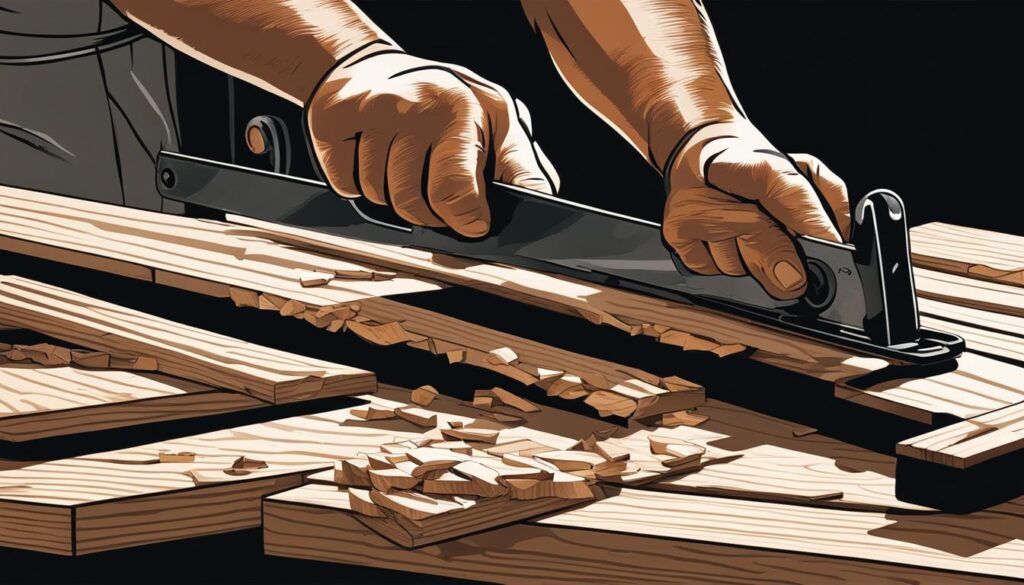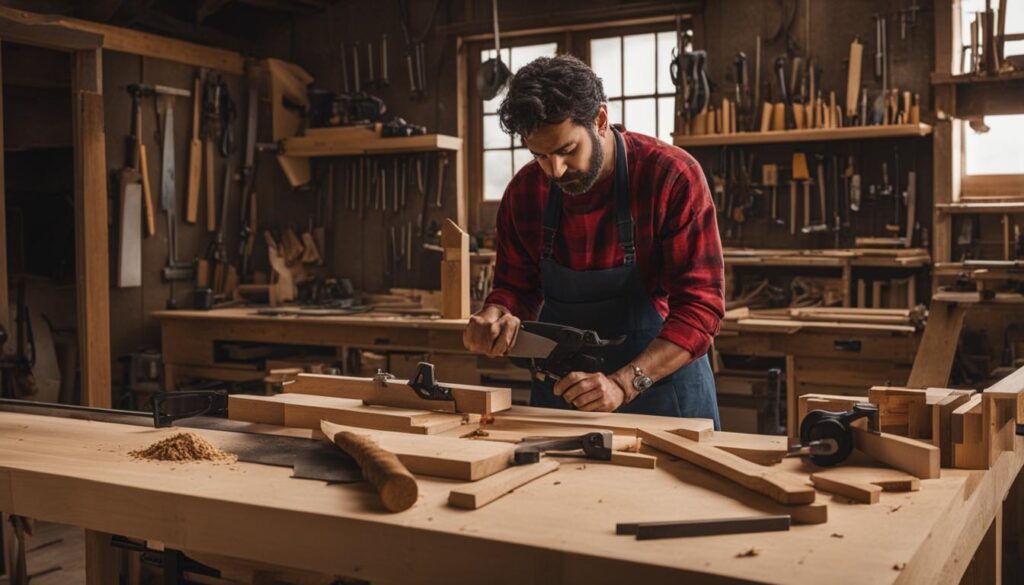We may earn money or products from the companies mentioned in this post.
Wood carving is an ancient art that can be mastered with practice and dedication. Whether you’re a complete beginner or have some experience, mastering the basics is the first step to becoming a skilled wood carver. In this comprehensive guide, we will introduce you to the exciting world of wood carving basics and provide you with the foundational knowledge you need to start your wood carving journey.
Key Takeaways:
- Wood carving is an ancient art that requires practice and dedication.
- Mastering the basics is the first step to becoming a skilled wood carver.
- Whether you’re a beginner or have some experience, this guide will provide you with the foundational knowledge you need to start your wood carving journey.
Understanding Wood Carving Techniques
If you’re new to wood carving, it’s essential to understand the different techniques involved in creating beautiful and intricate designs. Here, we will walk through the various techniques and tools used in wood carving that will help you achieve your desired results. From chisels and gouges to knives and saws, let’s dive into the world of wood carving tools and techniques.
Wood Carving Tools
Before we delve into specific techniques, let’s first look at the essential tools you’ll need for wood carving:
| Tool | Uses |
|---|---|
| Chisels | Perfect for creating straight lines and angles |
| Gouges | Used for creating curves and scoops |
| Knives | Great for detail work and precise cuts |
| Saws | Ideal for larger cuts and rough shaping |
With the right tools, you’ll be able to create intricate designs and shapes that will impress even the most experienced wood carvers.
Wood Carving Techniques
Now that you have an idea of the necessary tools, let’s explore the various techniques used in wood carving:
- Push Cut: Used for removing large amounts of wood quickly. The blade is pushed into the wood and then pushed forward in a slicing motion.
- Pull Cut: Used for finer cuts and removing smaller amounts of wood. The blade is drawn towards you in a pulling motion.
- Stop Cut: Used to outline designs and create defined edges. A shallow cut is made around the design to create a stopping point for deeper cuts.
- Chip Carving: Creates triangular-shaped cuts to create intricate designs and patterns.
- Relief Carving: Involves carving designs into the surface of the wood to create a three-dimensional effect.
These are just a few of the many techniques used in wood carving. Experiment with different techniques and find what works best for you and your project.
Wood Carving Tips
Finally, let’s look at some helpful tips to keep in mind when wood carving:
“Always use sharp tools. Dull tools can be dangerous and difficult to work with. Keep your tools sharpened and maintained regularly.”
“Be patient. Wood carving is a slow process that requires time and attention to detail. Rushing can lead to mistakes and frustration.”
With these tips and techniques in mind, you’re ready to start your wood carving journey. Remember to always prioritize safety and take the time to learn and practice new techniques. Happy carving!
Learning Wood Cutting Techniques
Wood cutting techniques are essential to the art of wood carving. They enable you to shape and sculpt wood with precision, allowing you to create intricate details and textures in your carvings.
The Basic Cuts
The two most fundamental cuts for beginners are push and pull. They are easy to learn and are used in almost all wood carving projects.
| Cut Type | Description |
|---|---|
| Push Cut | A push cut is made by pushing your chisel or knife through the wood away from your body. |
| Pull Cut | A pull cut is made by pulling your chisel or knife towards your body. |
Intermediate Cuts
Once you have mastered the basic cuts, you can move onto intermediate cutting techniques. Chip carving is a popular technique that involves making triangular cuts into the wood to create patterns and designs.
“Chip carving is a great way to add texture and pattern to your wood carvings. It takes a bit of practice, but the results are worth it!”
Advanced Cuts
Relief carving is an advanced technique that involves carving a design on a flat surface, creating the illusion of depth and dimension. It requires precise cuts and careful planning.
- Begin by outlining your design with a pencil.
- Use a chisel or knife to carefully remove the wood around the design, leaving the design raised.
- Refine your design by making additional cuts to add depth and texture.
With practice, you will be able to create intricate and beautiful relief carvings.
Learning these wood cutting techniques is the foundation of successful wood carving. Remember, practice makes perfect, so don’t be afraid to experiment and try new things!
Wood Carving Projects for Beginners
If you’re new to wood carving and looking for some fun and easy projects to get started, you’ve come to the right place! Here are a few ideas to inspire your creativity:
1. Simple Whittling
Whittling is the art of carving shapes out of a piece of wood using only a knife. It’s the perfect project for beginners because it requires minimal tools, and you can create beautiful designs with just a few simple cuts.
To get started, take a small block of softwood and start carving away the edges with your knife. Keep your knife sharp and your hands steady as you work on creating a basic shape. You can make anything from a small animal to a spoon or a letter opener.
2. Carve a Sign
If you’re feeling a bit more ambitious, try carving a sign for your home or garden. Choose a nice piece of wood and sketch out your design first. You can then use your carving tools to create the letters and any decorative elements.
Don’t be afraid to experiment with different fonts and styles. Once you’re finished, you can sand the sign down and apply a coat of varnish or paint to protect it from the elements.
3. Relief Carving
If you’re up for a challenge, try your hand at relief carving. This technique involves carving a design into a flat surface to create a three-dimensional effect. You can use this technique to create a beautiful wall hanging or a decorative box.
Start by drawing your design onto the wood and then use your carving tools to cut away the areas that should be raised. This can be a time-consuming process, but the end result is stunning.
4. Carve a Small Animal
Carving a small animal is a great way to practice your skills and create a cute decoration for your home. Start with a small piece of basswood or another softwood and sketch out your design.
Use your carving tools to create the basic shape and then add in the details such as eyes and fur. You can use sandpaper to smooth out any rough edges and finish the piece with a coat of paint or varnish.
These are just a few ideas to get you started with wood carving. Remember to take your time, be patient, and have fun with your projects. With practice, you’ll soon be creating beautiful works of art!
Mastering Wood Carving Basics
Congratulations on making it this far! By now, you should have a solid foundation in wood carving basics, including various techniques and helpful tips to enhance your skills. In this section, we will focus on taking your abilities to the next level.
Advanced Techniques
To master wood carving basics, you must continuously challenge yourself and experiment with new techniques. One advanced technique is chip carving, where you remove small chips of wood to create intricate designs. Another is relief carving, where you carve designs into the surface of the wood, creating a raised, three-dimensional effect.
Don’t be afraid to try new techniques and push yourself out of your comfort zone. The more you practice, the more confident you will become in your abilities.
Expert Tips
Learning from experts is a great way to improve your wood carving skills. Here are some tips from seasoned professionals:
- Keep your tools sharp to achieve clean cuts.
- Practice proper hand positioning for better control.
- Use light pressure when carving to avoid splitting the wood.
- Start with a rough sketch of your design before carving.
Following these tips will help you refine your technique and create professional-level wood carvings.
Explore New Styles
As you become more comfortable with basic techniques and advance your skills, don’t be afraid to explore new styles of wood carving. Try carving different types of wood, creating abstract designs, or incorporating multiple techniques into one project. The possibilities are endless!
Remember, wood carving is a form of artistic expression, and you should let your creativity guide you.
Conclusion
Thank you for reading our comprehensive guide to wood carving basics. We hope that you found it informative and inspiring. Remember that wood carving is an art form that requires patience, practice, and persistence.
Final tips for aspiring wood carvers
Here are some final tips to keep in mind as you continue your journey:
- Start with simple projects and gradually work your way up to more complex ones.
- Invest in quality tools that are comfortable to use and maintain them regularly.
- Practice proper safety techniques, such as wearing protective gear and working in a well-ventilated area.
- Find a community of fellow wood carvers to share ideas, tips, and inspiration.
- Don’t be afraid to experiment with different techniques and styles to find your unique voice as a wood carver.
With these tips and your newfound knowledge of wood carving basics, we’re confident that you’ll be well on your way to creating beautiful works of art that will last a lifetime.
FAQ
What tools do I need to start wood carving?
To start wood carving, you will need basic tools such as chisels, gouges, and knives. These tools will allow you to carve, shape, and sculpt the wood. It’s important to choose high-quality tools that are sharp and durable for optimal results.
Can anyone learn wood carving?
Yes, wood carving is a skill that can be learned by anyone. Whether you’re a complete beginner or have some experience, with practice and dedication, you can develop your wood carving skills. Start with simple projects and gradually work your way up to more complex designs.
How do I choose the right wood for carving?
When choosing wood for carving, it’s important to select a species that is dense and has a fine grain. Woods like basswood, butternut, and mahogany are popular choices for beginners due to their ease of carving. Avoid using softwoods like pine as they are more prone to splitting and may not hold intricate details well.
How do I maintain my wood carving tools?
Proper maintenance of your wood carving tools is essential to ensure their longevity and performance. After each use, clean the blades with a soft cloth to remove any wood dust or debris. You can also periodically sharpen the edges using a sharpening stone or honing guide to maintain their sharpness.
Are there any safety precautions I should take while wood carving?
Yes, safety should always be a priority when wood carving. Make sure to wear protective gear such as safety goggles and gloves to prevent any injuries. It’s also important to work in a well-ventilated area and keep your tools properly organized to avoid accidents. Always follow proper techniques and handle sharp tools with care.
Affiliate Disclosure: This post may contain affiliate links. If you purchase through our link, we may receive a small commission, but at no additional cost to you. For more information, please see our Disclosure statement.



